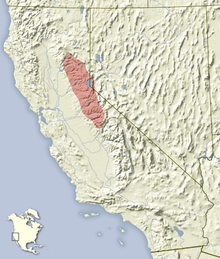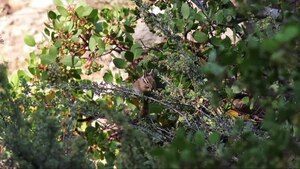Long-eared chipmunk
| Long-eared chipmunk | ||||||||||||
|---|---|---|---|---|---|---|---|---|---|---|---|---|

Long-eared chipmunk ( Tamias quadrimaculatus ) |
||||||||||||
| Systematics | ||||||||||||
|
||||||||||||
| Scientific name | ||||||||||||
| Tamias quadrimaculatus | ||||||||||||
| Gray , 1867 |
The long-eared chipmunk ( Tamias quadrimaculatus , syn .: Neotamias quadrimaculatus ) is a type of squirrel from the genus of the chipmunk ( Tamias ). It is endemic to the Sierra Nevada in eastern California and the far west of Nevada .
features
The long-eared chipmunk reaches an average head-trunk length of about 13.5 to 13.8 centimeters, the tail length is about 9.4 to 10.2 centimeters and the weight is about 78 to 88 grams. The back color is red-brown and, as with other species of the genus, there are several dark back stripes on the back, which are separated by lighter stripes and delimited from the sides of the body. It differs from most other types of chipmunks mainly by its long ears, the strong reddish brown color and the two bright white spots behind the ears (postauricular spots).
distribution
The long-eared chipmunk is found in the Sierra Nevada in eastern California in Plumas County and Mariposa Counties and in the far west of Nevada .
Way of life
Long-eared chipmunks live mainly in mixed coniferous forests of yellow pines ( Pinus ponderosa ), common Douglas fir ( Pseudotsuga menziesii ) and sugar pines ( Pinus lambertiana ). They prefer dense forest stands or loosened forests with dense undergrowth, dead wood , discarded run and branches and tree stumps.
The species is diurnal and primarily ground-living, but can also climb trees and bushes. The animals feed mainly herbivorous mushrooms, seeds and fruits. The composition of the food varies regionally, but the main component is mushrooms growing in the soil before seeds of the conifers. In addition, there are other parts of plants and insects as supplementary food. In doing so, they create food stores. The squirrels hibernate from November to late March, during which time they feed on the seed stores. The species is very active and less territorial than other chipmunks, but the animals and especially the males are aggressive towards other members of their own species during the mating season. The communication repertoire consists of a number of different "chips" and "chucks", depending on the background of the calls. Tail twitches are often associated with shouts, especially alarm calls. The territories comprise an average of 0.88 ha for the males and an average of 0.48 ha for the females. The density of individuals is around one animal per hectare.
The mating season for this species is between late April and early May, the gestation period is around 31 days and the young are born accordingly at the end of May to June. The number of young animals per litter varies from two to six animals, with only one litter per year.
Predators for the species have not been proven except for the attack of a rattlesnake , but as small mammals the animals are likely to be preyed on by various predators, birds of prey and snakes. In addition to the plague virus Yersinia pestis , the parasites identified are mainly fleas ( Catallagia culleni , Diamanus montanus , Oropsylla idahoensis , Monopsyllus eumolpi and Monopsyllus ciliatus ) and ticks ( Demacentor andersoni and Haemaphysalis leporispalustris ).
Systematics
The long-eared chipmunk is classified as an independent species within the genus of chipmunks ( Tamias ), which consists of 25 species. The first scientific description comes from the British naturalist John Edward Gray from 1867, who described it using individuals from Michigan Bluff in Placer County in California.
In 1985 the species was revised by Levenson et al. slammed with all other chipmunks of the genus Tamias . Within this, the Sonoma chipmunk is assigned to the subgenus Neotamias , together with most of the other species , which is also discussed as an independent genus. The long-eared chipmunk is assigned within the genus to a family group around the Townsend chipmunk ( Tamias townsendii ), which is referred to as the townsendii group. In addition to this species and the Townsend chipmunk , there are seven other species: T. senex , T. ochrogenys , T. siskiyou , T. merriami , T. sonomae , T. obscurus and T. dorsalis .
Apart from the nominate form, no subspecies are distinguished within the species .
Status, threat and protection
The long-eared chipmunk is classified by the International Union for Conservation of Nature and Natural Resources (IUCN) as “Least Concern” (LC). This is justified by the relatively large distribution area of more than 20,000 km 2 and the regular occurrence; there are no known risks to the existence of the plant.
supporting documents
- ↑ a b c d e f g h i Richard W. Thorington Jr. , John L. Koprowski, Michael A. Steele: Squirrels of the World. Johns Hopkins University Press, Baltimore MD 2012; Pp. 332-333. ISBN 978-1-4214-0469-1 .
- ^ A b Neotamias quadrimaculatus in the IUCN Red List of Threatened Species 2015.4. Posted by: AV Linzey, NatureServe (G. Hammerson), 2008. Retrieved June 18, 2016.
- ↑ a b Tamias (Neotamias) quadrimaculatus In: Don E. Wilson , DeeAnn M. Reeder (Ed.): Mammal Species of the World. A taxonomic and geographic Reference. 2 volumes. 3. Edition. Johns Hopkins University Press, Baltimore MD 2005, ISBN 0-8018-8221-4 .
- ^ Robin G. Clawson, Joseph A. Clawson, Troy L. Best : Tamias quadrimaculatus. Mammalian Species 469, 1994.
- ^ Howard Levenson, Robert S. Hoffmann, Charles F. Nadler, Ljerka Deutsch, Scott D. Freeman: Systematics of the Holarctic Chipmunks (Tamias). Journal of Mammalogy 66 (2), May 1985, pp. 219-242, doi : 10.2307 / 1381236 .
- ↑ Bruce D. Patterson, Ryan W. Norris: Towards a uniform nomenclature for ground squirrels: the status of the Holarctic chipmunks. Mammalia 80 (3), May 2016; Pp. 241-251 doi : 10.1515 / mammalia-2015-0004
- ^ Antoinette J. Piaggio, Greg S. Spicer: Molecular Phylogeny of the Chipmunk Genus Tamias Based on the Mitochondrial Cytochrome Oxidase Subunit II Gene. Journal of Mammalian Evolution 7 (3), September 2000, pp. 147-166, doi : 10.1023 / A: 1009484302799 . ( Full text )
- ^ Antoinette J. Piaggio, Greg S. Spicer: Molecular Phylogeny of the Chipmunks Inferred from Mitochondrial Cytochrome b and Cytochrome Oxidase II Gene Sequences. Molecular Phylogenetics and Evolution 20 (3), September 2001, pp. 335-350, doi : 10.1006 / mpev.2001.097 . ( Full text )
literature
- Richard W. Thorington Jr. , John L. Koprowski, Michael A. Steele: Squirrels of the World. Johns Hopkins University Press, Baltimore MD 2012; Pp. 332-333. ISBN 978-1-4214-0469-1
- Robin G. Clawson, Joseph A. Clawson, Troy L. Best : Tamias quadrimaculatus. Mammalian Species 469, 1994.
Web links
- Neotamias quadrimaculatus inthe IUCN Red List of Threatened Species 2015.4. Posted by: AV Linzey, NatureServe (G. Hammerson), 2008. Retrieved June 18, 2016.


